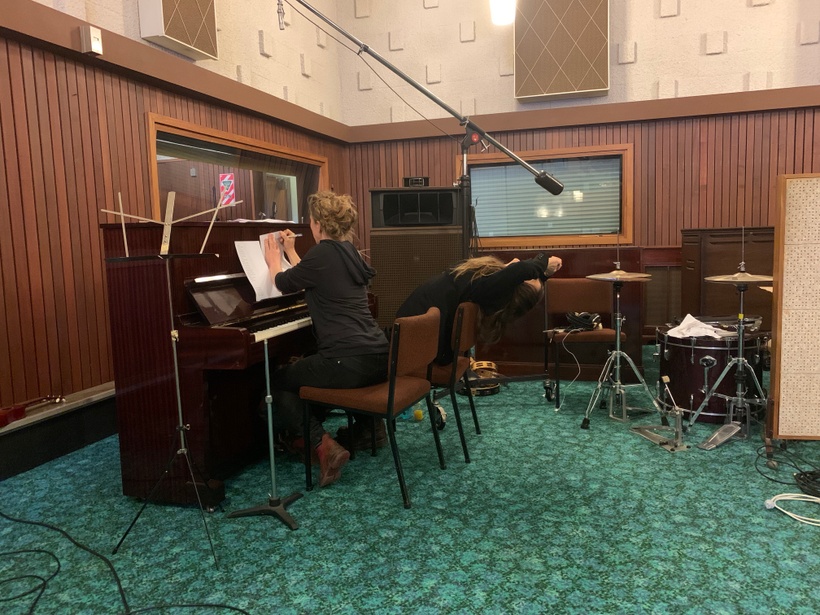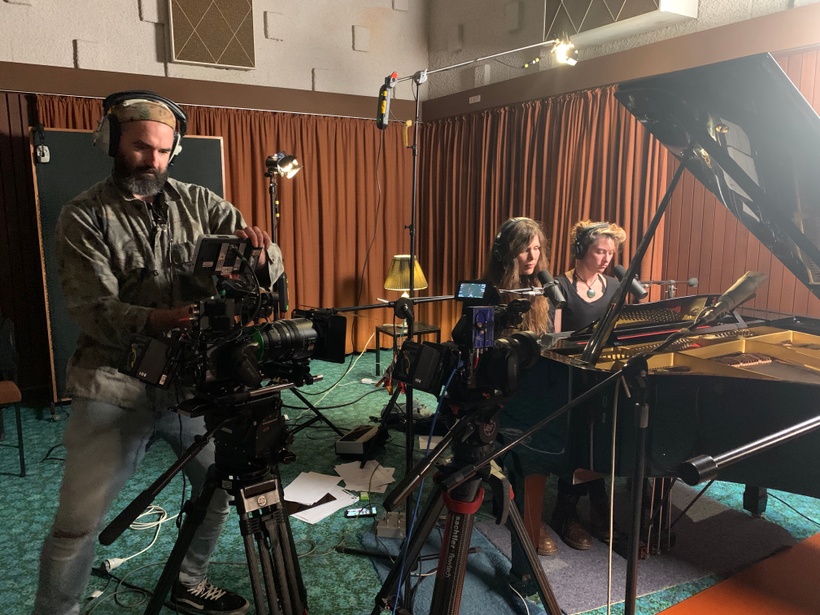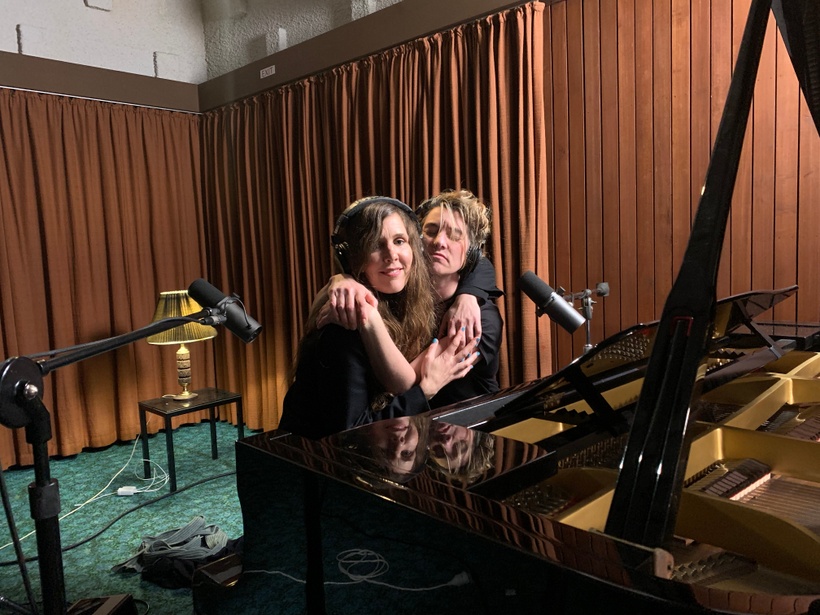At the start of this month, model Emily Ratajkowski made headlines for claiming that singer Robin Thicke had groped her while on the set for his “Blurred Lines” video. Just two days later, Amanda Palmer and Reb Fountain shared a video of the pair mashing up the song with Nirvana’s 1993 anti-rape single “Rape Me”. This wasn’t some sort of quick recording made as a way to capitalise on recent events, rather, it served as a startling piece of synchronicity that shows just how resonant the effects of Thicke’s “rape anthem” still are, almost nine years since its release.
Originally released back in March of 2013, the track quickly drew ire from just about everyone, with many either criticising the track’s lyrics (with its infamous “I know you want it” hook), or its accompanying video (which feature a number of topless women in its unrated version). Regardless of the criticism, the song’s mainstream popularity continued unabated, with the track going to top charts around the world and receive wider attention for effectively normalising rape culture.
Now, close to a decade since the song first found its way out into the world, Amanda Palmer and Reb Fountain have highlighted the misogyny that runs rampant throughout both the song and the wider culture with their live mashup of both “Blurred Lines” and Nirvana’s “Rape Me”.
As Palmer explained on a blog post to her Patreon subscribers, the cover came about after she had been approached by the Abortion Access Front‘s Lizz Winstead for their #DoReMeToo fundraiser, which annually asks women to cover famously sexist songs.
However, the journey to choosing the two tracks to mashup was not an easy one. Despite admitting that “Blurred Lines” is undeniably catchy despite its “truly sexist” content, the struggle of covering the song in a unique way presented a problem. Its simplistic chord structure was made catchy due to the production, and with a more bare-bones approach to covers, there needed to be a hook that made the song stand out.
After weeks of ruminating on the problem (and even revisiting songs from the likes of Burt Bacharach and Ted Nugent), frequent requests from patrons to cover “Rape Me” struck a chord, with Palmer explaining her frustration at songs such as this being taken literally, overlooking the nuance or grander commentary that they make.
Soon, inspiration struck again, with the idea of mashing the songs up to create a “conversation between songs, across two decades”.
Love Music?
Get your daily dose of everything happening in Australian/New Zealand music and globally.
Having been based in New Zealand since the beginning of the COVID pandemic last year, Palmer teamed up with Kiwi musician Reb Fountain (who Palmer has befriended before discovering they were cousins) in an Auckland studio to record the performance live.
As Fountain shares the infamous lyrics of “Blurred Lines”, simplistic piano chords pair with Palmer’s impassioned howl of Kurt Cobain’s lyrics, presenting a mesmerising, cathartic, and at times confronting combination of the two tracks which have polar opposite messages.
With the track out in the world for a few months now, Palmer spoke to Rolling Stone Australia about the creation of the track, and the power of being able to re-contextualise art in an attempt to change its meaning.
To start things off, let’s go back in time a few years to when “Blurred Lines” was first released. What was your reaction to hearing it for the first time all those years ago?
Well, when I first saw it on YouTube, it was being ripped to shreds and denounced by everyone I knew, and there was a slew of feminist parody videos; and doesn’t that say a lot about the filter bubbles of the web. For all I knew, “everybody” was laughing at this really cringe-y and pathetically sexist video. But that just goes to show that we all live in our little cultural caves.
The idea behind this performance first came by way of Lizz Winstead for the DoReMeToo fundraiser, with the idea being that you cover a “traditionally sexist song”. How quickly did “Blurred Lines” first come to mind for this one, and how did Nirvana’s “Rape Me” come into play?
I did what I often do when I’m working on a project like this: I went to my patrons and internet followers and asked for input. I wound up getting thousands of responses to the question “what’s the most sexist-ist song ever that I could ironically cover?” I spent a whole afternoon going through the lists, and didn’t even scratch the surface, but I came up with a list of about 20 contenders.
A song called “Wives and Lovers” was up there at the top with “Blurred Lines”. I’d never heard it before and good lord, if you want to hear something stomach-churning, go have a listen. But what actually brought the whole thing together were the few suggestions of “Rape Me”.
“I realised that there were more than a handful of people out there who didn’t understand that ‘Rape Me’ was an inherently anti-rape song.”
I realised that there were more than a handful of people out there who didn’t understand that “Rape Me” was an inherently anti-rape song. And especially as a songwriter whose material has been misinterpreted many times, I felt slightly indignant on Kurt Cobain’s behalf, and wanted to rectify things if I could. That’s when I realised that “Blurred Lines” and “Rape Me” not only had a similar chord structure, but could actually be placed, musically, into a sort of a super-sardonic conversation with one another.
What was the process behind its creation? You’re performing with Reb Fountain who – in addition to being a rather stellar musician – was not only someone you recently befriended, but also someone who holds a familial connection to you.
Reb is an undersung, powerhouse Kiwi songwriter and performer. She’s also got two kids, and she’s been through many a struggle. I saw her perform shortly after New Zealand came out of our first lockdown, and I knew I had found a soul-sister. We quickly became friends and started keeping track of one other, even though we lived in different parts of the country.
When we found out we both had Scottish family who hailed from the same clan on a tiny island in the northern highlands (the Isle of Skye, where my grandma is from), I wasn’t shocked. And in a funny way, it was deeply comforting to know that in this pandemic-waylaid moment, half a world away from my home, I’d found some family. I was so happy that she could carve out the time to do this project. It was a big ask.
You’ve obviously been quite open about your own personal experiences in the past, which have been known to help many struggling with telling their own story. What do you hope a performance like this can achieve?
Progress is slow, and sideways, and complicated. I think the important thing to remember is that progress in these areas – sexism, rape culture, abortion rights – is a long-tail game, and the worst thing we can do is shut up about it. That’s why I’m just constantly making work. Some things get 4,000 hits on YouTube, and some get 4 million. Some things will be misunderstood, some will resonate far and wide. The important thing is to keep banging on about the truth.
If women simply keep stating the case, the truth, the reality, over and over… it’s like water dripping on the stone of patriarchy. Enough voices and enough stories and enough people saying “enough is enough” will eventually turn the tide to the point where we don’t have to make work like this.
In addition, every piece of work like this, every story, every scream out of the dark – whether its stand-up comedy, or film, or fiction, or music, or a blog, or dance, or poetry, or whatever – every piece of truth inspires other voices to emerge. Sometimes I feel like my greatest successes haven’t been “commercial” ones, but just the pleasure of knowing that I’ve influenced other female artists to take up and wield their own sword.
Knowing that I’ve helped another woman turn up the dial on her truth-volume knob is almost more fulfilling than getting a prize for doing it myself. We’re a collective, we take turns at the wheel. At the end of the day, it almost doesn’t matter who’s saying it, and in what media, as long as it’s being said, constantly.

Palmer and Fountain working out arrangements for their mashup. (Photo by Victoria Bell)
You described the creative process behind this song as being a healing one. How was it helped you? Even a mere watching of the song feels like a cleansing, cathartic experience, so I can only imagine how it feels on your end.
Every time I make something about pain, abuse, grief, abortion, miscarriage, survival – you name it, – I feel stronger. Putting the story of pain into song-form is really relieving, and the truly therapeutic part comes not from the release of the material, but in the not-alone feeling I can provide for others, and myself. It’s why patronage and the internet are such fascinating tools. In the old days, you had to perform live to get that sort of communal relief and feeling, and nowadays, you can hold the communal discussion online. I still think there’s something more powerful about doing this kind of catharsis in person, but hey, it’s a pandemic and I’m in New Zealand. There isn’t a whole lot I can do about that.
One important thing to point out is that this whole thing would not have happened without my patrons. in the past, had I wanted to film and release something like this, I would have had to dig into my own pocket, and work on the assumption that I’d just lose money in order to pay for the privilege of sharing content like this. and indeed, I used to do that all the time. But now, with patronage, I can make totally non=profit and commercial-free art like this and actually have the funds to pay the staff and filmmakers and engineers without losing money.
I cannot stress how important I think this is going to be for activists and feminists, and women in general, moving forward. We’ve all seen what happens with art and culture where the profit is the main concern, the main motive. Now, with patronage, we’ll get to see what happens when supporting and amplifying the artist’s voice is the main motive, instead of “sales”.
I think it’s gonna be revolutionary. If it can give birth to something like this video, which never would have existed with the dough from my Patreon, just imagine what else might happen when the fierce woman artists of the world, the get ahold of this vehicle and start making unapologetic art, funded by the people who want their voices amplified, while being beholden to no brands, no labels, no channels, no corporations? It’s gonna be wild. it’s gonna change everything.
“It’s all a reminder that art can access and heal places in us that almost nothing else can.”
What has the sort of response to this song been so far from fans?
It’s been overwhelmingly positive, and galvanising. When you make art like this, it’s like an invitation to let people tell their stories, to openly share, to grieve, to scream themselves. nothing is more valuable to me than the comments from people — of all sexes — saying things like “this helped me process something that I’ve never been able to process” or “it’s been twenty years and I’m finally crying about….”
It’s all a reminder that art can access and heal places in us that almost nothing else can. And it’s a real alchemy – as the artist, you never know which particular medicine is gonna go down and do the work. You can guess, but you’re almost never right. your only hope is to stay in the kitchen, keep pouring ingredients into the cauldron, keep mixing, keep hoping. And sometimes you make something like this and strike gold, and it helps you to understand your recipe for the next time.

Director of Photography Olly Harris setting up to record Fountain and Palmer’s mashup. (Photo by Victoria Bell)
The arrival of this song is also incredibly timely too, given that it had been recorded in August – a month and a half before Emily Ratajkowski claimed that Robin Thicke groped her on the set of the “Blurred Lines” video – and released just days after this all came to light. How does it feel releasing a song such as this at such a relevant time? It must be such a mixed bag of emotions given that even eight years after its release, a song such as this is still making news for the wrong reasons.
Well, another wonderful thing about patronage is that you can make something in the instant, put it out in the instant, and get paid for your work without waiting eighteen months for a paltry royalty check. I got this idea very quickly, called Reb, and a few days later we were in the recording studio, slapping the arrangement together, and then it only took about a couple weeks before the video was unleashed.
There were two massive coincidences; one was that it coincided with the twentieth anniversary of In Utero (the album “Rape Me” is on), and the other was Robin Thicke hitting the headlines again. When those things happen, by accident, you just gotta wonder. But as far as “making news for the wrong reasons”, I’d disagree. I think it’s good for us to constantly revisit things, mash them up, discuss them, wonder about them, and most importantly: contextualise them.
I’m a big believer in free speech, and I do think we do ourselves, and our culture, a disservice if we are ever tempted to “disappear” art, or “cancel” it completely. It’s a way stronger and more empowered move to keep difficult art – and artists – in the cultural conversation, but with a frame of discussion around it that teaches, that enlightens.
“Making a mashup song like this is the musical equivalent of taking a Confederate statue, and – instead of just smelting it down or boxing it up in a basement – re-contextualising it by featuring it in a museum exhibit about racism in America.”
Making a mashup song like this is the musical equivalent of taking a Confederate statue, and – instead of just smelting it down or boxing it up in a basement – re-contextualising it by featuring it in a museum exhibit about racism in America. Or, even better, in a museum exhibit where local artists of colour are called to re-decorate the statues with whatever they feel moved by: paint, moss, blood, glitter glue, silly hats.
There’s nothing more powerful than taking art and reformatting it, and re-contextualising old art to fit the present moment. That’s the biggest fear I have about cancel culture: art has to be a living conversation. Conversations are difficult. But when you simply shut down the conversation, everybody eventually loses.

Fountain and Palmer hugging following the recording of their performance. (Photo by Victoria Bell)


































